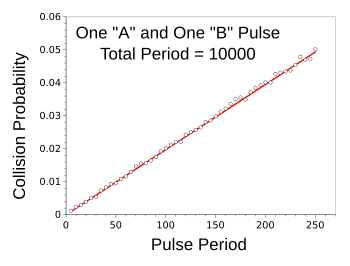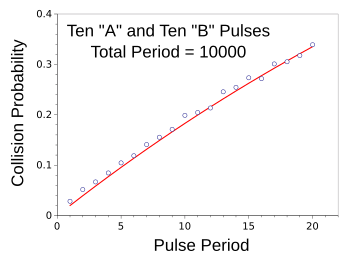Collisions
April 6, 2017
When a
physics blog presents an article about
collisions, one might assume that the topic is
classical mechanics, or the
statistical mechanics that leads to the
thermodynamic behavior of
gases.
Billiards is a good example of collisions between objects, and there are demonstrations of things such as the
conservation of momentum using
billiard balls. What's more interesting is the idea that
elastic collisions between billiard balls can be used for
computation.
The idea of a
billiard ball computer appears in a 1982
paper by
Edward Fredkin and
Tommaso Toffoli.[1] Fredkin is noted also for the concept of the
Fredkin gate, a
logic gate that allows
reversible computing. The Fredkin gate is universal, meaning that any
logical operation can be done using Fredkin gates. Fredkin was
co-inventor, with
Marvin Minsky, of the
Triadex Muse music synthesizer, a device that produced
algorithmic musical sequences based on
parameter settings for
pitch,
volume, and
tempo.[2]
Fredkin is also a proponent of the interesting concept that the
laws of physics actually arise from a simple
algorithm that controls the operation of the
universe. The
complexity of today's universe is explained by the idea that
iteration of this simple algorithm has been going on for
a long time. I'm reminded of
John Wheeler's "
It from bit" concept that I wrote about in a
previous article (It from Bit, July 8, 2013).
Fredkin and Toffoli's fundamental concept was that a
computer could be built as a suitably-shaped container filled with an
ideal gas, the elastic collisions of the ideal gas
molecules, constrained to move within the passages of the container, doing the
computation. In an upwardly scaled
conceptual model, perfectly elastic billiard balls on a
frictionless platform replace the ideal gas molecules. An example billiard ball logic gate is shown in the figure.

A billiard ball implementation of an AND gate, as proposed by Fredkin and Toffoli. When two balls simultaneously enter the gate, their collision results in the ejection of one ball through the output port. It can be seen that synchronization of the input signals is essential to proper operation. (Wikimedia Commons image, modified using Inkscape.)
Now that we've entered of realm of the "
Internet of Things," there are many devices in our
homes,
offices, and
factories that collect
data for
transmission to a central
server. Since many of these devices are
battery-powered, or rely on
environmental energy-harvesting techniques for power, they transmit infrequently. As an energy-savings measure, they don't listen before transmission, and this leads to another type of collision when two devices transmit data at the same time.
The only way that a
receiver can handle such a collision is to discard both
data streams and obtain the data at a later time when there is no collision. If the transmitting devices are somehow synchronized, as when they are identical devices, started at the same time, and running the same code, their data will just collide at the next transmission time. One way to prevent collision is to have the devices transmit at
random intervals; provided, however, that identical devices can be
seeded to yield different
random sequences.
If such devices do transmit at random intervals, how often would collisions occur?
Fabian Schneider has published a paper on
arXiv that provides some insight into this problem.[3] Schneider has provided
equations for determining the
probability P of two randomly occurring independent events,
A and
B, will occur simultaneously when they happen
nA and
nB times in an interval
T and last for periods
tA and
tB. He gives the following example for the process.
"John works inside his office for 2 hours. A blue car will occur 10 times on the nearby street and remains visible for 1 minute each time. John looks outside 5 times for 3 minutes each. How likely is John going to see a blue car?: T = 120 min, tA = 3 min, tB = 1 min, nA = 5, nB = 10 and we are about to determine P (120, 3, 1, 5, 10)."[3]
Schneider presents an exact solution for the case in which the events,
A and
B, occur just once in the interval, as follows:

He also presents a close
approximation of
P for any given values of
nA and
nB.

I tested these results with a
computer simulation (
C language source code here). For the case of events,
A and
B, occurring just once in the interval, I got the following result.

Collision probability as a function of pulse width, for one A and one B pulse of the same width in an interval.
The red line shows the predicted values.
(Computer simulation data, graphed using Gnumeric.)
The fit of the equation to the data is superb. For the case in which the events,
A and
B, occur ten times in the interval, I got the following result.

Collision probability as a function of pulse width, for ten A pulses and ten B pulses of same width in an interval.
The red line shows the predicted values.
(Computer simulation data, graphed using Gnumeric.)
The fit of the data to the second, approximation, equation is also superb.
References:
- E. Fredkin and T. Toffoli, International Journal of Theoretical Physics, vol. 21, no. 3 (April, 1982), pp. 219-253, doi:10.1007/BF01857727.
- Edward Fredkin and Marvin L Minsky, "Digital music synthesizer," US Patent No. 3,610,801, October 5, 1971.
- Fabian Schneider, "How likely are two independent recurrent events to occur simultaneously during a given time?" arXiv, December 23, 2016
Permanent Link to this article
Linked Keywords: Physics; blog; collision; classical mechanics; statistical mechanics; thermodynamic; gas; billiards; conservation of momentum; billiard ball; elastic collision; computation; billiard ball computer; scientific literature; paper; Edward Fredkin; Tommaso Toffoli; Fredkin gate; logic gate; reversible computing; Boolean algebra; logical operation; invention; inventor; Marvin Minsky; Triadex Muse; electronic music synthesizer; algorithmic composition; algorithmic musical sequence; parameter; pitch; loudness; volume; tempo; physical law; laws of physics; algorithm; universe; complexity; Fredkin finite nature hypothesis; iteration; age of the universe; John Archibald Wheeler; It from bit; computer; ideal gas; molecule; computation; conceptual model; friction; AND gate; synchronization; Wikimedia Commons; Inkscape; Internet of Things; home; office; factory; data; data transmission; server; battery-powered; environmental energy-harvesting; radio receiver; bitstream; data stream; randomness; random; random seed; pseudorandom number generator; random sequence; Fabian Schneider; arXiv; equation; probability; approximation; computer simulation; C programming language; source code; collision.c; Gnumeric.